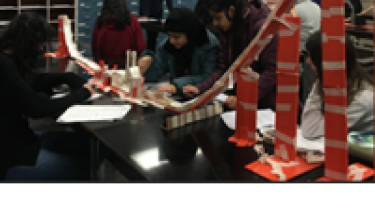
News From the Nest-Spotlight on Learning: What is the best roller coaster design?
Spotlight On Learning
Presented by: Ms. Teresa Homoncik
Subject: Science 10
Driving Question: Roller Coaster Design
TEACHER DESCRIPTION and / or REFLECTION:
The challenge of the Roller Coaster Design Project is to see which group can build a roller coaster out of paper and cardboard that minimizes the production of unintended energies. Unintended energies are created because of friction, as well as a lack of sturdiness in the design which causes energy to be transformed into unnecessary motion. This year we threw in a new question for the students to explore. I wanted students to determine whether a larger or smaller ball would come closer to the student’s calculations on paper. Student calculations on paper assume NO unintended energy loss. What I like about this project is that it reinforces all the theory and calculations that we spent time on during the Physics Unit and creates a real-life situation where they have to take every “bump” in their track and actual measurement into consideration. It also shows the need for collaboration between group members.
STUDENT REFLECTIONS:
Muntaha Waqar
This project forced me to think critically and use many problem solving skills which helped reinforce my understanding of Physics. Having a physical object rather than a worksheet helped a lot as we, as a group, were able to see how much of a difference in speed a single bump can make.
Parmeet Kaur
Making a roller coaster was challenging. Making it stable was the hardest part. Doing the “frictionless” calculations to determine the speed of the ball and comparing it to the actual speed of the ball showed us how successful we were in creating our roller coaster. It enhanced my knowledge of Physics greatly and it made more sense when we actual did it.
Sukhmeet Gill à
I got to see a real, physical object and how Physics applied to it, and how the calculations can change if there’s even a small bump in the track. I learned you have to be accurate with your measurements (when cutting the flaps for the ramp, the width, the angle at which the roller coaster drops at the start and the initial height of the roller coaster, etc) so that it has enough energy to make it to the end.
Tanish Shah
This project has opened my eyes to the practical aspect of the Physics that I’ve learned in class. I learned about how to eliminate unwanted energy and see what curves, measurements, and designs worked best, all through trial and error. This project gave me the opportunity to plan, design, explore, and lead a group, all while strengthening and conceptualizing my understanding of Physics and Energy! This project forced me to think critically and use many problem solving skills which helped reinforce my understanding of Physics. Having a physical object rather than a worksheet helped a lot as we, as a group, were able to see how much of a difference in speed a single bump can make.